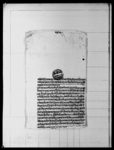A lālamohara from King Rājendra appointing Raṃjīta Giri as overseer of sannyāsīs (V.S. 1898)
ID: DNA_0015_0033
Edited and
translated by Christof Zotter
Created: 2015-02-14;
Last modified: 2018-06-22
For the metadata of the document, click here
The accompanying edition, translation/synopsis and/or commentary are available under the terms of the Creative Commons Attribution-ShareAlike 4.0 International License
Abstract
This edict from King Rājendra grants Raṃjīta Giri the office of central overseer (mahantamaṇḍalāi) of sannyāsīs under a one-year contract (ijārā) and defines further details relating to this privilege.Diplomatic edition
[1r]
1श्रीदुर्गाज्यूः\[royal seal]1स्वस्तिश्रीगिरिराजचक्रचूडामणिनरनारायणेत्यादिविविधविरुदावलीविराजमान2मान्नोतश्रीमन्महाराजाधिराजश्रीश्रीश्रीमहाराजराजेन्द्रविक्रमसाहवहादूरसम्से
3रजङ्गदेवानांसदासमरविजयीनाम्¯ ¯ ¯ ¯ ¯ ¯ ¯ ¯ ¯ ¯ ¯
4आगेसहरकाठमाडौकाव्यासेभुटोलवस्न्यागोसाञीरंजीतगिरिकेसहरकाठमा
5डौसहरपाटन्सहरभादगाउगैह्रनेपालषालटाभरऔमेचिपश्चिमभेडाहा
6उत्तर•भेरिपूर्व•रसुवादक्षिणयेतिराजेभित्रकामहंतमंडलीसम्वत्१८९८सा
7लमितिवैसाषवदि१रोजदेषिचैत्रसुदि१५सम्मवर्ष१कोइजारागरिवक्स्यौंआ
8फ्नाषातीरजामासंगसंन्यासिछेउकोमर्योअपुतालीमाघरषेत्वाहेकडंडकुं
9डपंचषत्औउम्य्रालीद्वारिवितलप•विर्ताटुसालछतिसैजातभित्रवस्न्यासंन्या
10सिहायु•दनुव़ारदरैंकुह्माल•चेपांपहरिमाझिछेउपरापूर्वदेषिलाग्याको•दै
11दस्तुरलिनु•असलसित•जातमानचलाऊनु•कमसलसितनमिसनु•संन्यासि
12कोपरिआयाकोचंन्द्रायनचलाउनु•वर्ष१कोसावीकरुपैया१८७।।साल९७
13देषिबढ्याकोरुपैया२०दुवैवेमोजरैज्मारुपैया२०७।।दर्वारदाषीलगर्नुभा
14रादारजागीरदार•सुवासुवेदारअमालीद्वार्याविर्तवार•तलप्याकसैलेमंड
15लिकोरकममाहेमायेत्नगर्नु•हेमायेतगर्याकाठाउमारकमचलाइदिनु•सं
16न्यासिमंडलीकाठाऊमाहेमायेत्गर्नामापस्याडंडपर्लाइतिसम्वत्१८९८
17सालमितिप्रआश्वीनसुदी१४रोज४शुभ्म्¯¯ ¯¯ ¯¯ ¯¯
Translation
[1r]
Venerable Durgājyū
Hail! [A decree] of him who is shining with manifold rows of eulogy [such as] "The venerable crest-jewel of the multitude of mountain kings" and Naranārāyaṇa (an epithet of Kṛṣṇa) etc., high in honour, the venerable supreme king of great kings, the thrice venerable great king, Rājendra Vikrama Sāha, the brave swordsman, the divine king always triumphant in war.
[Regarding] the following: to the gosāīRaṃjīta Giri living in Byāsebhuṭola in the city of Kathmandu
We [hereby] execute a one-year contract (ijārā) [with you] as central overseer (mahantamaṇḍalī) [of the sannyāsīs] from the 1st day of the dark half of Vaiśākha, Saṃvat year 1898 to the 15th of the bright half of Caitra in the whole Kathmandu Valley (nepālakhalaṭābhara), [i.e.] the city of Kathmandu, the city of Patan, the city of Bhaktapur etc., and in [that part of] the kingdom (yeti rāje) west of the Mecī, north of the Bheḍāhā, east of the Bherī [and] south of the Rasuvā. Collect (linu) with content (āphnā khātīrajāmāsaṃga) the sannyāsīs' escheated property (maryoaputālī)—except for houses and fields—the judicial fines (daṇḍakuṇḍa) [and the penalties for] the five heinous crimes (pañcakhata), and—[with the help of] the umyrālīs (for umarāu?), dvāres, bitalapa (for bitalapyā?) and birtāṭusāla (?) 1 —the customary fee (daidastura) prevalent from olden times (parāpūrvadekhi lāgyāko) from the sannyāsīs living amongst the 36 jātas (i.e. householder sannyāsīs),2 the hāyūs, danuvāras, darāis, kumāles, cepaṅs, paharis [and] mājhīs. Uphold caste and creed honestly (asalasita jātamāna calāunu). Do not become involved in what is base. Uphold the traditional (pariāyeko) candrāyana (for cāndrāyaṇa?).3 Present to the palace the previously customary (sābika) 187½ rupees for one year [along with] the increase of 20 rupees [valid] since the year [VS 18]97, the two totalling, with no deduction (bemojarai), 207½ rupees. No bhārādāra, jāgīradāra, subbā, subedāra, amālī, dvāre, birtāvāra, talapya (for bitalapyā?) [or] anyone [else] shall show [any] favoritism when [collecting] maṇḍalī money. Collect money instead of showing favoritism. If favoritism is shown in sannyāsīmaṇḍalī locales, it will be punished.
Wednesday, the 14th day of the bright fortnight of the first Āśvina of the [Vikrama] era year 1898 (1841 CE). Auspiciousness.
Commentary
Also available are a number of royal orders addressed to officials in different parts of the kingdom and instructing them to collect revenue for Raṃjīta Giri (see DNA_0013_0059, DNA_0015_0031, DNA_0016_0075).

